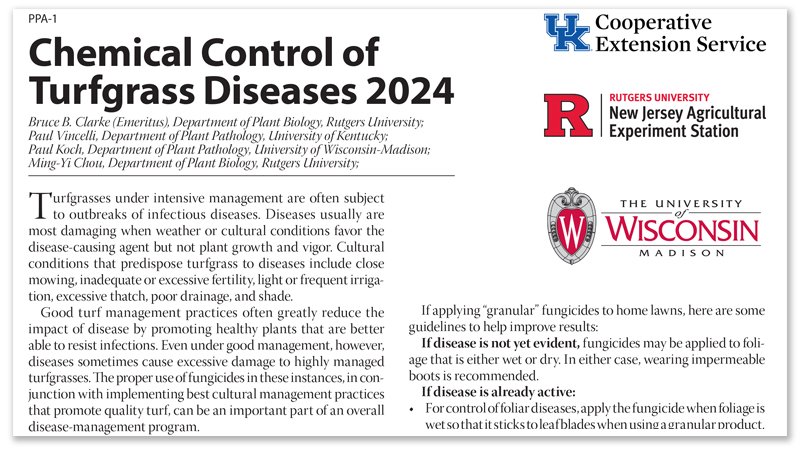The bible for fungicide use to control diseases in turfgrass has evolved quite a bit in the past three decades.
When Paul Vincelli, Ph.D., began his career in plant pathology at the University of Kentucky in 1990, the publication titled Chemical Control of Turfgrass Diseases, was little more than a diagnosis guide and a catalog of products available at the time. The guide quickly became much more soon after his UK colleague Bill Nesmith, Ph.D., told Vincelli that turf managers wanted to know what works best for a specific disease, not just what is available.
Eventually, Vincelli devised a rating system that graded product efficacy and the publication has become the go-to guide for diagnosing and controlling diseases in turf, and since 2017 has been administered by plant pathologists at other universities, namely Bruce Clarke, Ph.D., at Rutgers and Paul Koch, Ph.D. of the University of Wisconsin. Previous editions were made possible by efforts from turf pathologists at Purdue University and the University of Missouri.
The guide, which is available as a free download through the University of Kentucky, contains information on more than two dozen common turfgrass diseases and how to control them.
It includes conditions and seasons under which each disease thrives, how to make the correct diagnosis as well as agronomic and chemical solutions for each.
The guide proffers FRAC code, fungicide group, risk of resistance, mobility in the profile and trade names of each fungicide product covered. It also has key data for dozens of premixed and combination products. Perhaps the most important contribution of the guide is a grading system that assigns an efficacy rating for each disease.
Diseases covered in the guide include algae, anthracnose, brown patch, brown ring patch, copper spot, dollar spot, fairy ring, gray leaf spot, gray speckled snow mold, large patch, leaf smuts, leaf spot and melting out, necrotic ring spot, pink snow mold, powdery mildew, Pythium blight, Pythium root dysfunction, red thread, Rhizoctonia leaf and sheath spot, rusts, slime molds, spring dead spot, summer patch, take-all patch, yellow patch and yellow and yellow tuft.
Other tips offered are directions for proper application and the importance of testing products and evaluating whether fungicidal control is the best course of action for a specific site and application.
A compendium of scientific research conducted nationwide, the publication concludes with a glossary of helpful links as well as acknowledgements of those whose work was used to compile the guide.



